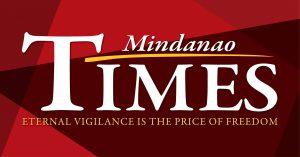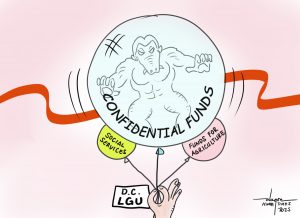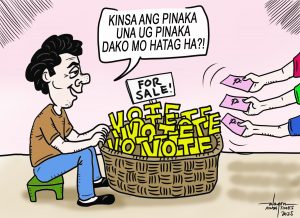Last of Seven Parts
The Tri-People Approach: Citizens’ Participation in Creating A Culture of Peace (Editor’s note: This article is a slight revision of the lectures the author delivered between the years 1999 and 2000 to two major audiences — the Center for Media Freedom and Responsibility in Metro Manila and the Bishops-Ulama Forum, now known as Bishops-Ulama Conference, in Davao City.)
(Editor’s note: This article is a slight revision of the lectures the author delivered between the years 1999 and 2000 to two major audiences — the Center for Media Freedom and Responsibility in Metro Manila and the Bishops-Ulama Forum, now known as Bishops-Ulama Conference, in Davao City.)
The marginalization experienced by the Lumad and the Moros in the last one hundred years are not perceived as acts of fraternal love from either government or settlers or corporate institutions. They have reacted to this each in their own way.
The MNLF led the Bangsamoro in an armed struggle for national liberation. The Lumad founded the Lumad Mindanaw and articulated their own desire for genuine self-determination in their own ancestral lands. Recent events and circumstances have changed for the better. Already we have the GRP-MNLF Peace Agreement for the Moro people and we have the Indigenous Peoples Rights Act for the Lumad. The energy of sustained implementation must be consciously maintained by the people themselves. But how?
Some Basic realities to Consider
In creating a culture of peace in Mindanaw, we need to acknowledge some very basic realities or make some fundamental assumptions. First is that Mindanaw is inhabited by a population that may be classified into three distinct segments, namely, the Lumad, the Muslims and the settlers. Second, at this point in our history, not a single segment of the population can claim Mindanaw as theirs any longer; Mindanaw is shared territory.
Third, despite their differences, the three segments of the population are capable of working out a modus vivendi that can make Mindanaw a home of peace and harmony. There are more than enough examples of this.
What Mindanaw has taught us is that we can still be Filipinos, but the basis of our unity cannot be our differing experiences with Spanish or American colonialism. It must be our mutual acceptance of one another as distinct peoples in one nation, sharing the same territory. It must be our common vision crafted from present realities.
We have also learned that the major segments of the population must take part in identifying what is common among them and working out a modus vivendi from there. This is not something that can be the subject of negotiation between the GRP and the MNLF.
Perhaps, this is one moment in history when we must grapple with realities in a manner radically different from the way the colonizers did it for us. If we must unite, we must do so as to distinct entities; we must do so as equals accepting and respecting each other’s unique identity and dignity — regardless of population size, and we must do so because unity in diversity is mutually beneficial and best for all concerned.
This is an important first step in the creation of a culture of peace as well as in the unification of the Filipino people in this part of the nation. Balanced with one another, ethnicity can be an instrument for sustaining a peace culture – which, in turn, is a vital component for the development, not only of the autonomous region but also of Mindanaw and the Philippines.
Peace Credo; the Organic Whole;
Implications to Development
At a gathering of peace advocates and educators at the South East Asia Rural Leadership Institute (SEARSOLIN), Xavier University, Cagayan de Oro City, on July 4-6, 1996, called Consultation-Workshop on Peace Education in Mindanaw with the theme: Journey to Peace and Harmony, which was jointly hosted by the Mindanaw Support and Communication Center for Agrarian Reform and Rural Development (MINCARRD) and the Office of the Presidential Adviser on the Peace Process (OPAPP), the participants produced, ratified and adopted a Peace Credo in Filipino, now translated in 19 languages. The English translation here is mine. It is very appropriate to recall it here.
Kalinaw Mindanaw!!!
Lumad, Muslim, Kristiyano
Magkaiba, Magkaisa
Isang Diyos
Isang Lupain
Isang Adhikain
Kalinaw Mindanaw!
[English Translation]
Peace Mindanaw!!!
Lumad, Muslim, Christian
They are different, they can be one
One God
One land
One dream
Peace Mindanaw!!!
A Maguindanawon introduced the music. To a great extent the consciousness that was created in that forum has found a home in the heart of all peace advocates associated with Kalinaw Mindanaw.
What it advocates is that at the level of the people, we should encourage the tri-people approach in peace advocacy. This means creating a stream of unifying ideal among the Lumad, the Muslims and the migrants whose basic interests may sometimes be conflicting. It is molding a common agenda and a common vision; it is creating unity out of diversity. It is seeing ourselves as integral parts of an organic whole.
Following the idea of an organic whole, the same people will do well to see themselves as one with nature and the physical environment in which they live. Then from there, find the inter links, or the unifying thread among the various forces of nature. With a closer look, one can easily see the interactive roles of the various resources or forces of development in Mindanaw in the overall forward movement of the region and the country.
(MindaViews is the opinion section of MindaNews. A peace specialist, Rudy Buhay Rodil is an active Mindanao historian and peace advocate.)


